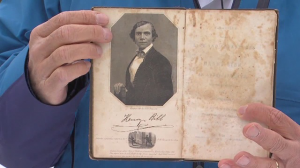The Oberlin-Wellington Rescuers 1859
THE TOWN THAT STARTED THE CIVIL WAR?
Founded in 1833, by John Shipherd and Philo Stewart, the town of Oberlin and its College were meant to be an evangelical community that would educate ministers and teachers to save the “Godless West.” Since both town and college were founded together, it is impossible to separate the two when examining either one.
From the beginning, Oberlin was different from any other school and community in the nation. Oberlin was the first coeducational college in the United States where women and men were taught in the same classrooms. In 1834, Oberlin changed its admission policies and drew national attention. The college faculty voted that the Collegiate Institute would admit students “irrespective of color.” This change in the admission policy came from the appointment of Asa Mahon as the first President of the college. In 1835, Oberlin admitted James Bradley, who became the first African American to attend Oberlin College.
In June of 1835, the Oberlin Anti-Slavery Society was created and by the end of the year the society had 300 members. The anti-slavery society in Oberlin is important because it reaffirmed the community’s commitment to opposing slavery and, also, because it was one of few anti-slavery societies in northern Ohio. Oberlin’s participation in anti-slavery activities and the community’s commitment to the education of blacks gained national attention and separated Oberlin from its surrounding communities.
Oberlin became a major focus in the abolition movement in the middle of the nineteenth century. Every chance given they opposed the Fugitive Slave Act and did everything possible to make sure enslaved blacks were not returned to the south. The most famous example is what is known as the Oberlin-Wellington Rescue. John Price, a young black man was approached and offered work by Shakespeare Boynton, a son of an Oberlin land holder. However, this was a trap and Price soon found himself kidnapped by Kentucky slave catchers and two Columbus deputies. The news reached Oberlin and a crowd of both black and white men and women went to the Wadsworth Hotel in Wellington where Price was being held. The crowd demanded Price’s release and when negotiations failed, the crowd rushed the hotel and in the chaos Price was rushed into a buggy and taken back to Oberlin. Hidden in Oberlin College President James Fairchild’s attic for a few days, Price was then sent on to Canada and never heard from again. Twenty-seven men who aided in Price’s escape were arrested for opposing the Fugitive Slave Act. While awaiting trial, the men chose to stay in jail and printed the newspaper “The Rescuer.” On July 7, 1859, the Kentucky Slave catchers were arrested and charged with the kidnapping of John Price, and all but one of the twenty-seven men were released from jail and the charges were dropped.
Before the Civil War the Oberlin community was an active stop on the Underground Railroad. After the Civil War, Oberlin continued it’s tradition with admitting students “irrespective of color.” Some of the more famous graduates are Rosetta Douglas, daughter of Frederick Douglas, Mary Church Terrell who became the first President of the National Association of Colored Women’s Club and Anna Julia Cooper who taught at M Street High School, Washington’s first black high school.
History of the Oberlin Underground Railroad Center Project


